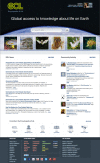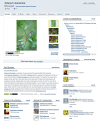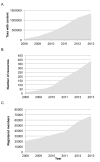The Encyclopedia of Life v2: Providing Global Access to Knowledge About Life on Earth
- PMID: 24891832
- PMCID: PMC4031434
- DOI: 10.3897/BDJ.2.e1079
The Encyclopedia of Life v2: Providing Global Access to Knowledge About Life on Earth
Abstract
The Encyclopedia of Life (EOL, http://eol.org) aims to provide unprecedented global access to a broad range of information about life on Earth. It currently contains 3.5 million distinct pages for taxa and provides content for 1.3 million of those pages. The content is primarily contributed by EOL content partners (providers) that have a more limited geographic, taxonomic or topical scope. EOL aggregates these data and automatically integrates them based on associated scientific names and other classification information. EOL also provides interfaces for curation and direct content addition. All materials in EOL are either in the public domain or licensed under a Creative Commons license. In addition to the web interface, EOL is also accessible through an Application Programming Interface. In this paper, we review recent developments added for Version 2 of the web site and subsequent releases through Version 2.2, which have made EOL more engaging, personal, accessible and internationalizable. We outline the core features and technical architecture of the system. We summarize milestones achieved so far by EOL to present results of the current system implementation and establish benchmarks upon which to judge future improvements. We have shown that it is possible to successfully integrate large amounts of descriptive biodiversity data from diverse sources into a robust, standards-based, dynamic, and scalable infrastructure. Increasing global participation and the emergence of EOL-powered applications demonstrate that EOL is becoming a significant resource for anyone interested in biological diversity.
Figures












Similar articles
-
Reol: R interface to the Encyclopedia of Life.Ecol Evol. 2014 Jun;4(12):2577-83. doi: 10.1002/ece3.1109. Epub 2014 May 26. Ecol Evol. 2014. PMID: 25360287 Free PMC article.
-
ENVIRONMENTS and EOL: identification of Environment Ontology terms in text and the annotation of the Encyclopedia of Life.Bioinformatics. 2015 Jun 1;31(11):1872-4. doi: 10.1093/bioinformatics/btv045. Epub 2015 Jan 24. Bioinformatics. 2015. PMID: 25619994 Free PMC article.
-
BioNames: linking taxonomy, texts, and trees.PeerJ. 2013 Oct 29;1:e190. doi: 10.7717/peerj.190. eCollection 2013. PeerJ. 2013. PMID: 24244913 Free PMC article.
-
A mini-review of end-of-life management of wind turbines: Current practices and closing the circular economy gap.Waste Manag Res. 2022 Dec;40(12):1730-1744. doi: 10.1177/0734242X221105434. Epub 2022 Jun 28. Waste Manag Res. 2022. PMID: 35765772 Review.
-
Environmental hazards associated with open-beach breaking of end-of-life ships: a review.Environ Sci Pollut Res Int. 2018 Nov;25(31):30880-30893. doi: 10.1007/s11356-018-3159-8. Epub 2018 Sep 14. Environ Sci Pollut Res Int. 2018. PMID: 30215211 Review.
Cited by
-
20 GB in 10 minutes: a case for linking major biodiversity databases using an open socio-technical infrastructure and a pragmatic, cross-institutional collaboration.PeerJ Comput Sci. 2018 Sep 17;4:e164. doi: 10.7717/peerj-cs.164. eCollection 2018. PeerJ Comput Sci. 2018. PMID: 33816817 Free PMC article.
-
A comprehensive view of the web-resources related to sericulture.Database (Oxford). 2016 Jun 15;2016:baw086. doi: 10.1093/database/baw086. Print 2016. Database (Oxford). 2016. PMID: 27307138 Free PMC article. Review.
-
No evidence for a signal in mammalian basal metabolic rate associated with a fossorial lifestyle.Sci Rep. 2024 May 17;14(1):11297. doi: 10.1038/s41598-024-61595-1. Sci Rep. 2024. PMID: 38760353 Free PMC article.
-
Ecological Predictors of Organelle Genome Evolution: Phylogenetic Correlations with Taxonomically Broad, Sparse, Unsystematized Data.Syst Biol. 2024 Jul 27;73(2):419-433. doi: 10.1093/sysbio/syae009. Syst Biol. 2024. PMID: 38459872 Free PMC article.
-
Constructing a biodiversity terminological inventory.PLoS One. 2017 Apr 17;12(4):e0175277. doi: 10.1371/journal.pone.0175277. eCollection 2017. PLoS One. 2017. PMID: 28414821 Free PMC article.
References
-
- Ahn Wook, Hammock Jennifer, Parr Cynthia, Preece Jennifer, Shneiderman Ben, Schulz Katja, Hansen Derek, Rotman Dana, He Yurong. Visually Exploring Social Participation in Encyclopedia of Life; Social Informatics; Lausanne. Dec 14-16, 2012; 2012. 8. - DOI
LinkOut - more resources
Full Text Sources
Other Literature Sources
